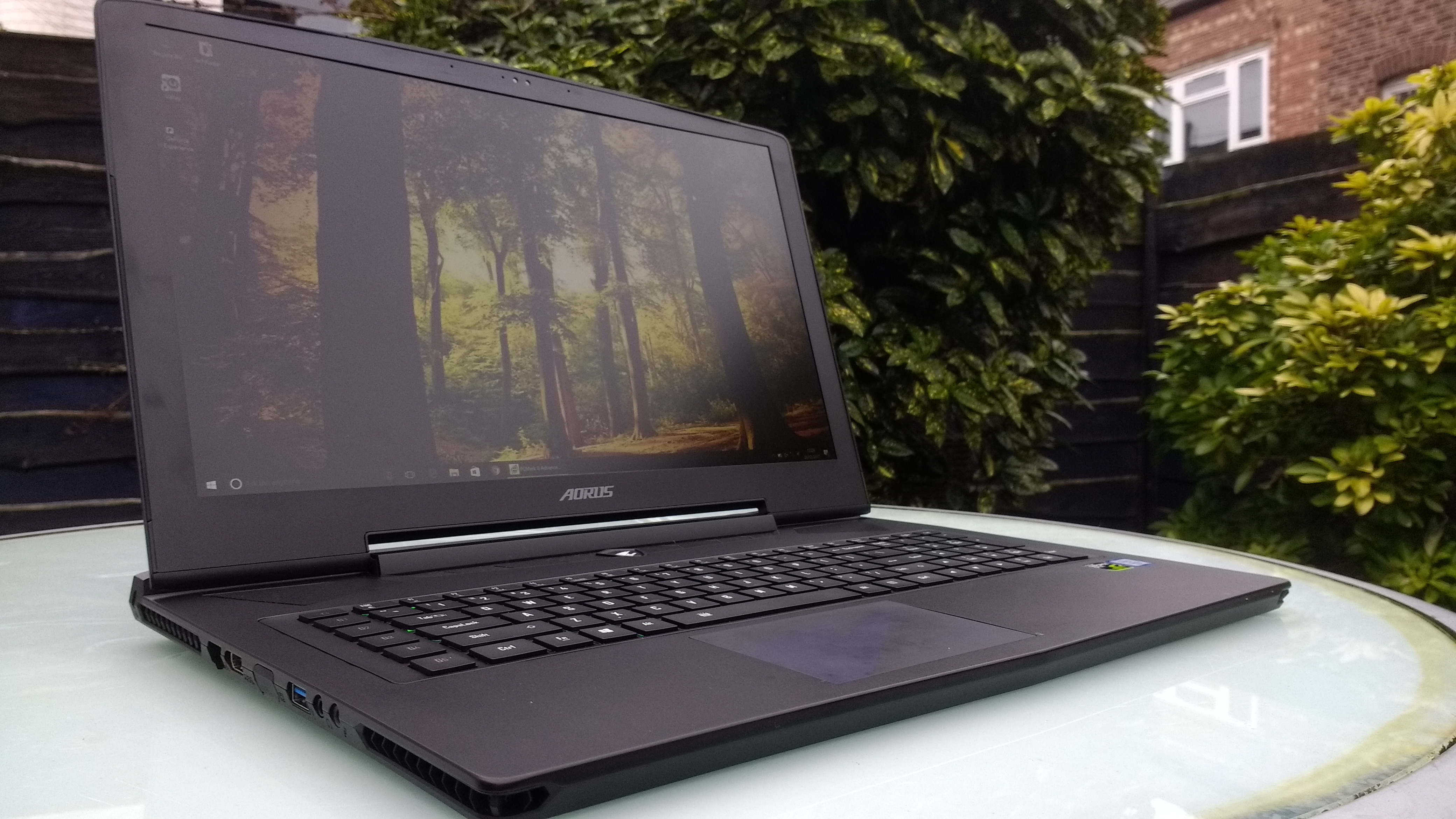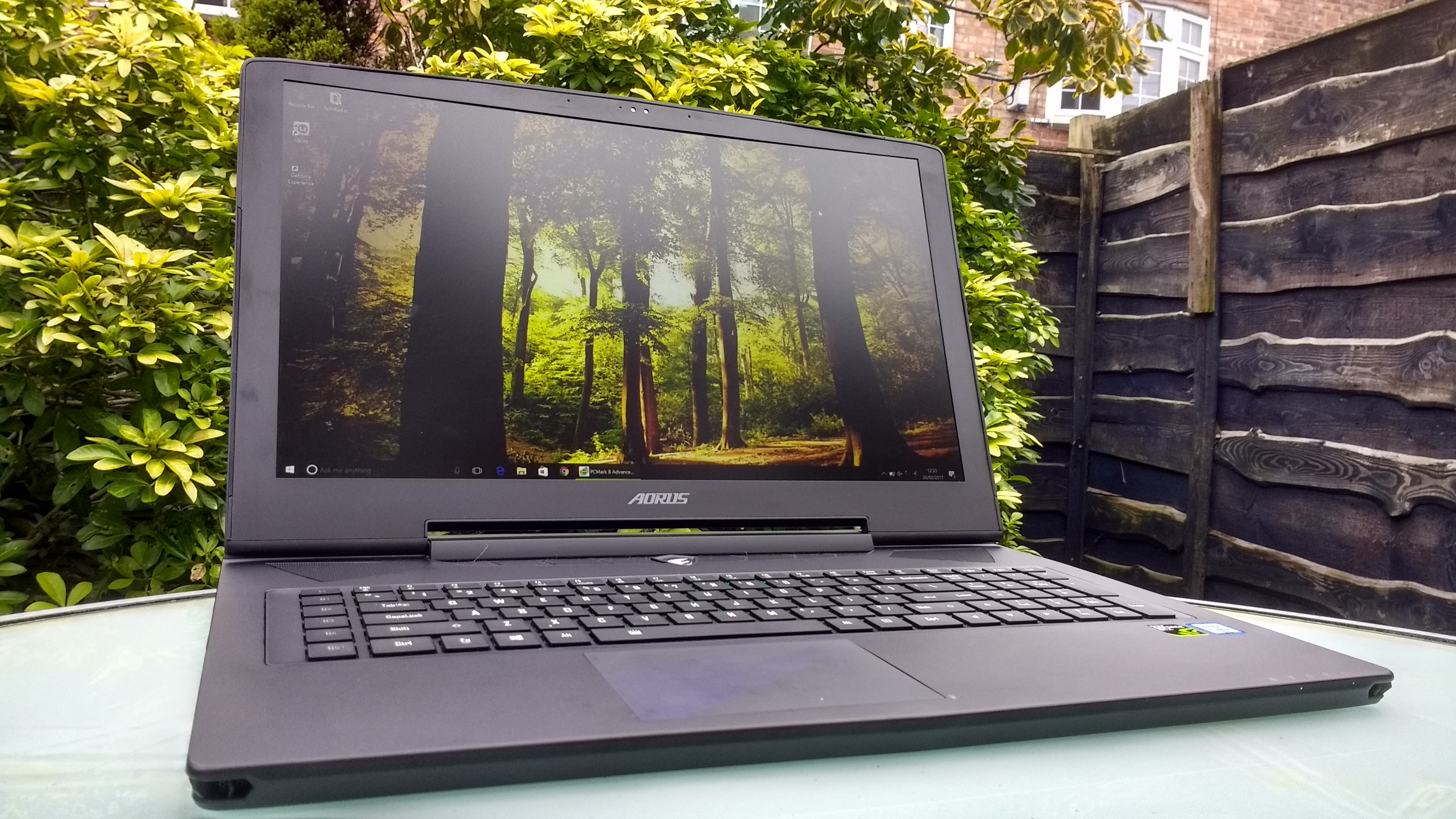Why you can trust TechRadar
Here is the Aorus X7 v6 configuration sent to TechRadar for review:
CPU: Intel Core i7-6820HK (2.7GHz-3.6GHz)
Graphics: NVIDIA GeForce GTX 1070 GDDR5 8GB
RAM: 16GB DDR4 2400 MHz SO-DIMM, 4 slots (Max 64GB)
Screen: 17.3-inch QHD 2560x1440 120Hz & 5ms with G-SYNC
Storage: 512GB SSD (M.2 PCIe NVMe) & 1TB HDD (SATA)
Ports: HDMI 2.0, Nvidia Surround, mini DP, RJ45, USB 3.0 (Type-A), USB 3.1 (Type-C), Earphone (With SPDIF out), MIC in, SD Card Reader (PCIe interface)
Connectivity: Killer LAN Chip, Wireless LAN: Killer Wireless-AC 1535 (802.11ac, a/b/g/n compatible), Bluetooth V4.1 + LE
Camera: HD Camera
Weight: 3.2kg / 7.05 US lb
Size: 16.85 x 12 x 0.90 inches / 428mm x 305mm x 22.9mm (W x D x H)
The good news is that this is an incredibly fast beast with an i7-6820HK Skylake inside. It’s a CPU which runs at a faster clock speed (by 0.1GHz) than a 6700HQ which is in the Gigabyte P37X and HP Omen 17.
It also has an unlocked multiplier, which means it can be overclocked within Windows using Aorus’ Command & Control software up to a whopping 4.0GHz.
It is, however, looking a little long in the tooth. It was released back in 2015 and with the newest Kaby Lakes just have been released this may not be as future proof as other upcoming setups.
Our test machine came with a gamer friendly amount of RAM, 16GB of DDR4 2400, and its upgradable to a maximum of 64GB. Unfortunately, the base is attached using speciality Torx screws so you’ll need to buy a special screwdriver if you’re thinking of upgrading to that magical 64GB.
Permanent storage is courtesy of an M.2 PCIe 512GB SSD for the OS and a 1TB for everything else. More than generous we thought, but if that’s not enough it’s possible to upgrade using three 512GB M.2 PCIe SSDs and one 2TB HDD, providing you a massive 3.5TB.
Here’s how the Aorus X7 v6 performed in our suite of benchmark tests:
3DMark: Cloud Gate: 27,382; Sky Diver: 30,837; Fire Strike: 13,968 Time Spy: 5,406
Cinebench: CPU: 710; Graphics: 105.33 fps
PCMark 8 Home: 3641
PCMark 8 Battery Life: 1 hours, 17 minutes
Geekbench: Single: 4,135 Multi: 13,796
GTA V: Ultra: 57.4 Low: 164.1
The Division: [1080p, Ultra]: 80.9 fps; [1080p, Low]: 195.4 fps
Performance
For the benchmarks, we set the Command & Control software to overclock the CPU to 4.0 GHz and turned the fans to the gaming setting. This did mean it got quite loud during the tests, and belted out heat from the rear vents. It’s a laptop in name only, so we’d recommend setting this up on a large well-ventilated desk for best results. Also due to the fan noise, consider noise-cancelling headphones when playing demanding titles.
That being said, it breezed through The Division at just over 80fps on Ultra, and nearly hit 200fps on Low. Its scores bested both the Gigabyte P37X v6, HP Omen 17 and Acer Predator 17x.
Sign up for breaking news, reviews, opinion, top tech deals, and more.
It also stormed through out other benchmark tests too, beating its aforementioned rivals on almost everything except the Geekbench Multi Core test where the Predator just edged in front. Most impressive were its 3D Mark tests which easily outshone the others by a few thousand or more in each test. Sky Diver clocked in a particularly impressive 30,837.
It’s obvious that a 1070 coupled with the overclocked processor is a winning combination. The GPU also means that it’s VR Ready, and the SteamVR Performance Test reflects this in a score of 9.9 (Very Good).
The only place where it fell down, and it fell down pretty far, was with its the battery life or rather, lack of it. In the PC Mark 8 Battery Test, it couldn’t even hit 1 hour 30, limping to 1 hour 17. Altering the settings didn’t help much either, on lowest brightness and a throttled CPU it only managed 1 hour 24 which is pretty dismal.
On paper it should be better than the Gigabyte P37X as it’s got a 94.24Wh battery compared to the P37X’s 75.81Wh. However the Gigabyte racked up over double the battery time than the Aorus at 3 hours 23 mins.
Admittedly, this is foremost a gaming laptop, so it’s not intended to be used while travelling or to be away from a power supply for long, but we would have liked to have seen a little more oomph in the battery department.

We liked
Aorus has created a very high performing 17.3-inch gaming laptop that’s portable and is encompassed in an attractive package. It achieved exemplary scores in our benchmarks, no doubt due to the overclockable CPU under the hood. Aorus’ coupled software makes the tricksy dark magic of overclocking a doddle.
We disliked
The X7 v6 is a little pricey, not necessarily over-priced as it does come with excellent components, however if you’re looking for better value with only slightly lower performance we’ve recommend something like HP’s Omen 17 or Acer’s Predator 17 X.
The battery life is very below par, and the screen wasn’t up to scratch either. It’s a pity as if both of these things had been up scratch then this would have been an excellent machine, despite the slightly higher price.
Final verdict
Aorus just missed the goal with the updated X7. On paper it’s incredible (if a bit expensive), but in reality the screen and battery life woes means this upgrade just hit the post. However if you have a bit of money to spend, are looking for an overclockable and VR-ready unit, and don’t care much for battery life then this might be for you.
